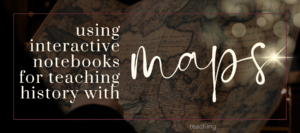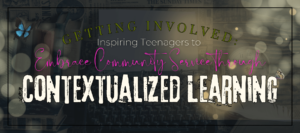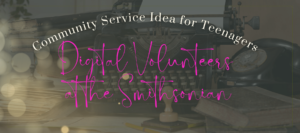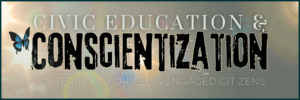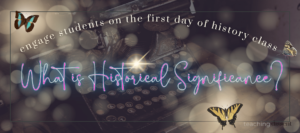Community service for teenagers is the exact time to combine theory and action: its the perfect opportunity to integrate social studies (civics education) with language arts instruction (reflection narrative essay) and assessment. Guided by requirements to teach the responsibilities of citizenship (civic duty, community engagement as a cornerstone to purpose of government…) and my own hopes and dreams to combine this as a milestone of personal development to young people, I wanted to really drive home the concept that each young person is a potential agent of change, a contributor to their larger societal narrative. Contextualized learning emphasizes the interconnectedness of education with the real-world context in which it is applied. Rooted in the philosophy of praxis, this approach encourages students to actively engage with the subject matter in a manner that is directly relevant to their lives and the society they inhabit.
The importance of contextualizing community service for teenagers
The importance of contextualizing community service for teenagers lies in the transformative potential of combining education with real-world experiences. Contextualized learning goes beyond rote memorization, emphasizing the significance of placing knowledge within a relevant framework that resonates with the learners. It’s the bridge that connects theory and practice, a dynamic process that involves reflection on the world around them and taking meaningful steps to effect change. As we know, for teenagers, understanding the relevance of what they learn is crucial. Contextualized learning shows them how academic concepts directly relate to their lives, addressing the perennial question of “Why do I need to learn this?”
Teachers play a pivotal role in this process by engaging students in discussions about issues that matter to them, connecting the educational content to their own world. Real-world issues, such as government and civic responsibility, are explored collaboratively with input from students. Critical thinking is encouraged, as they analyze government decisions and ethical implications.
Crucially, the praxis component comes into play as students take practical action. They might organize voter registration drives, write letters to elected officials, or participate in local protests. Such practical engagement empowers them and reinforces the belief that they can make a difference. Post-action reflection enhances their understanding and informs their future endeavors, completing the praxis cycle.
Community service, which is an integral part of this approach, is essential in shaping teenagers’ development. It instills a sense of purpose and responsibility, offering a glimpse into the realities beyond their own world. By actively participating in volunteer work, they gain a broader perspective and a deeper understanding of the challenges faced by others. Engaging in community service cultivates empathy and compassion. The direct impact of their actions allows teenagers to comprehend the power of kindness and witness the difference they can make. This experience shapes their character, fostering empathy, gratitude, humility, and appreciation for their privileges. Moreover, the emphasis on social-emotional learning (SEL) in schools is shown to lay the groundwork for increased civic participation among young people, further enhancing their civic and interpersonal skills.
Community service offers teenagers an opportunity to develop leadership skills that will serve them for years to come, enabling them to communicate, collaborate, and problem-solve effectively. These skills will prove invaluable in all areas of their lives. Lastly, engaging in community service allows teenagers to build meaningful social connections, expanding their horizons and forming lasting relationships
Benefits of Community Service for Teenagers
By contextualizing learning within the realm of civic responsibility and civic virtue, students can better appreciate the relevance of government and civic engagement in their lives, develop into critical thinkers who challenge the status quo, and become empowered citizens who actively contribute to their communities. This praxis shifts the educational paradigm, granting students agency in their learning journey: instead of being passive recipients of information, they become active participants who take responsibility for their education. This not only enhances their understanding and retention of knowledge but has also been proven to foster a sense of ownership over individual learning.
Moreover, the development of critical thinking skills is a cornerstone of this approach. Students are encouraged to question assumptions, evaluate the outcomes of their actions, and adapt their strategies accordingly. They don’t just memorize facts and theories but understand how these concepts apply to real-world situations. This equips them with the ability to navigate the complexities of our interconnected world and engage in informed civic discourse.
Empowerment, or conscientization, is another significant benefit of contextualizing community service projects and grounding them at the intersection of civic education and the reflection process. Students discover that they have a voice and the ability to effect change in their communities. This sense of agency, of kids discovering their own self-worth along with their capacity to enact real, positive change is so important for active citizenship because it instils the belief that they can make a difference in their own communities (and the world at large).
The broader implications of this approach extend to the educational system and society as a whole. It empowers students by giving them agency in their education, fostering a sense of ownership over their learning journey. Moreover, it produces critical thinkers who are better equipped to engage in informed civic discourse, strengthening the democratic process. An informed and active citizenry is essential for the functioning of a healthy democracy. In the context of high school civic education, this cyclical process of praxis as transformation significantly impacts students and the broader community. It encourages active citizenship development, bridges the gap between theory and reality, empowers students, fosters critical thinking and problem-solving, and builds stronger bonds within local communities. It lays the foundation for a more engaged, informed, and compassionate society, where students are not just passive learners but active agents of positive change.
Inspiring teenagers to get involved in community service

I think the most important thing to keep in mind when working with teenagers is that they see through everything. If you don’t believe in what you are saying with your whole heart, I swear- they can sense it.
Inspiring teenagers to get involved in community service can be a transformative journey that begins with fostering an environment of active learning. Instead of a traditional lecture, start with discussions on the role of government in society. Encourage students to share their thoughts and opinions about what they believe the purpose of government should be. In this open dialogue, students may argue that the government’s primary role is to protect citizens’ rights and maintain law and order, while others might emphasize the government’s responsibility to address social and economic inequalities. Present real-life examples to contextualize their learning, allowing students to analyze how government actions and policies align with their own ideas about the government’s purpose. For instance, they may examine healthcare reforms or responses to environmental issues. This active learning environment provides an opportunity for students to voice their perspectives on government, fostering critical thinking and encouraging them to consider various viewpoints.
The journey towards inspiring teenagers to engage in community service encompasses multiple phases. Phase 1 involves a critical examination of civic responsibility and civic virtue. Students explore questions like, “What does it mean to be a responsible citizen?” and “How do civic virtues contribute to a healthy democracy?” Starting with dialogue and followed by critical reflection, you begin to connect theoretical knowledge with personal experiences and beliefs.
Of course, if you really want to inspire teenagers, you have to lead by example.
Thats the thing about them- they see through everything. Adults in their lives, including parents, teachers, and mentors, should also actively engage in community service and involve teenagers in their activities. By experiencing the joy and fulfillment that comes from helping others, teenagers are more likely to follow suit. They can tell when you are faking, but they can also tell when you mean it.
Also, connecting community service with their passions and interests is key. Encouraging teenagers to think about the causes they actually care about and how they can contribute to making a difference aligns community service with their motivations. Offering a variety of service opportunities that cater to diverse skills and preferences gives teenagers a sense of autonomy and choice, increasing their motivation and commitment.
You can’t do any of this without creating a supportive and inclusive environment. Encouraging teamwork and fostering a sense of community among students allows teenagers to feel valued and part of a larger cause, ultimately inspiring them to continue their involvement in community service. This holistic approach, encompassing active learning, critical examination, real-life examples, and hands-on community involvement, empowers teenagers to become active citizens who shape their communities and society as a whole. It not only broadens their understanding of government and society but also equips them with the skills needed to advocate for positive change, fostering a lifelong commitment to community service and civic engagement.






